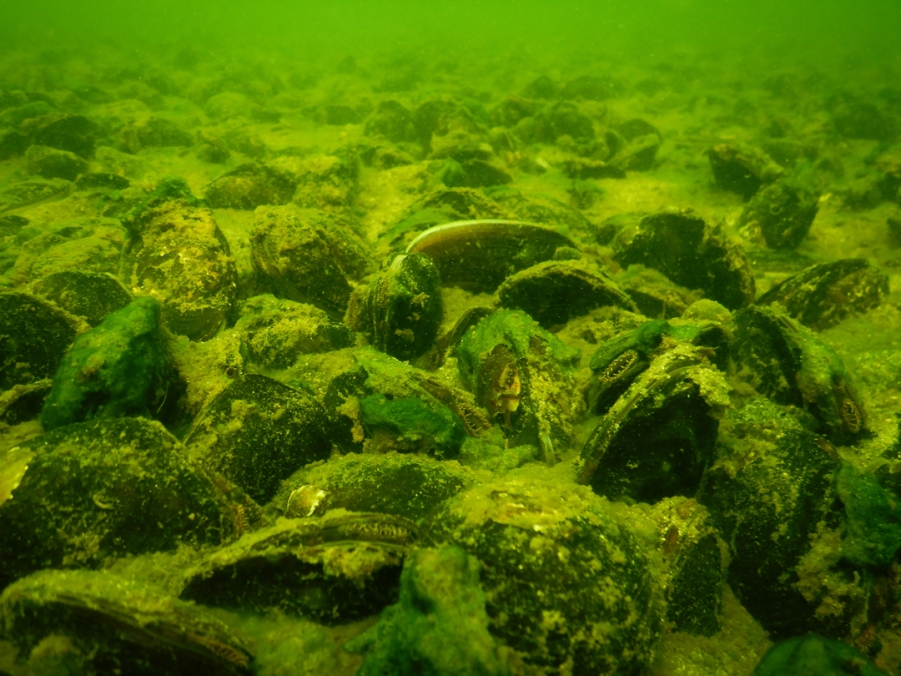On this page
Click button below to view other species in series
What's a kākahi and where can you find it?
Kākahi (also known by the names kāeo and torewai) are a native species of freshwater mussel found in Aotearoa.
There are three species of kākahi identified so far. All three species look slightly different and are found living together, or on their own, in different regions of Aotearoa. Kākahi live in freshwater environments ranging from small fast-flowing streams to large lakes. Kākahi are long-lived, with one species (Echyridella menziesii) estimated to live on average between 12 -30 years, but can live as long as 50 - 60 years. Unlike marine mussels that attach themselves to surrounding rocks or other substrates, kākahi use their foot to move around, anchor themselves and burrow into sediment.
- Echyridella menziesii This species is found in New Zealand’s lakes and streams from Cape Reinga in the North Island to Lake Hauroko in the South Island. It can grow up to 11cm long and is often found in fine sand or silt.
- Echyridella onekaka This special species was discovered in 2006 in a man-made pond in Lake Onekaka, West Nelson. They are only found in the northwest of the South Island. They are very similar in size and shape to E. menziesii.
- Echyridella aucklandica Echyridella aucklandica is mainly found in the North Island, from Waikato northward. They are also found in Whanganui, Lake Wairarapa and Lake Hauroko in Southland. This unusual distribution may be due to translocation by Māori. The adult mussel can grow up to 11 to 13cm long.
Why are kākahi so important?
Kākahi are a bioindicator in freshwater environments, and are important for the water quality of freshwater environments for many reasons. Juvenile kakahi live within the sediment bed of streams, rivers and lakes for at least five years before they emerge.
Young kākahi require a healthy environment to live in, including clean water and substrate that is not too silty and won’t clog their gills. This makes them a good indicator of the quality of a ecosystem.
Kākahi anatomy
The basic anatomy of a kākahi includes:
- Shell The hard, external part of a kākahi is made mostly of a type of calcium carbonate which offers protection.
- Adductor muscles Large muscles which keep the shell closed.
- Mantle A thin membrane on the inside of the shell which protects the kākahi and secretes the shell.
- Visceral mass The main body (flesh) of the kākahi which contains internal organs such as the heart and intestine.
- Gills Found on each side of the foot is a thin double gill used for the intake of oxygen. This is also where a female kākahi keeps her larvae.
- Siphons There is an inhalant and exhalant siphon. Water for breathing and filter feeding is sucked in through the inhalant siphon, and out through the exhalant siphon. The inhalant siphon of a kākahi is fringed with sensory papillae.
- Foot This is a strong muscle that the kākahi uses to move, anchor and burrow. Juvenile kākahi also use their foot to feed.
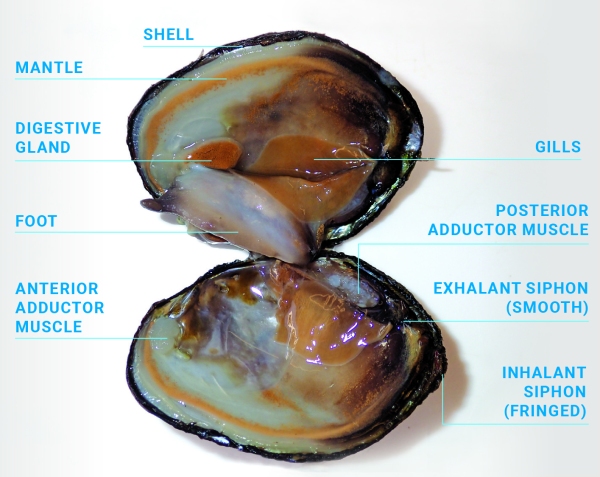
Attribution, Non-Commercial, No Derivative Work
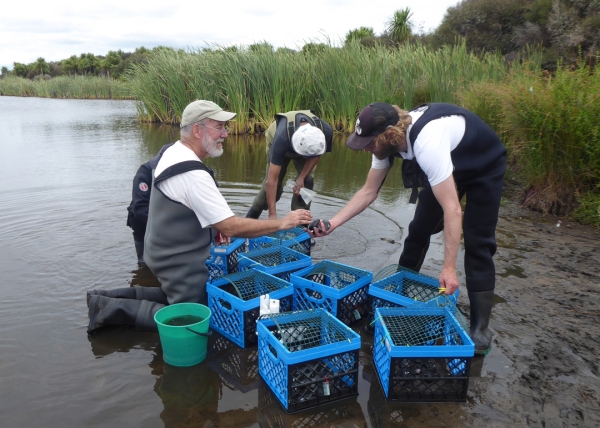
Attribution, Non-Commercial, No Derivative Work
Can kākahi help clean our lakes?
Research is under way to develop and test bioremediation rafts to harness the filter feeding capacity of native freshwater mussels. Scientists are studying whether the kākahi on these rafts can assist lake restoration through biofiltration. If so these kākahi rafts could become part of the solution to return degraded, turbid, shallow lakes towards their original clear, native aquatic plant dominated state.
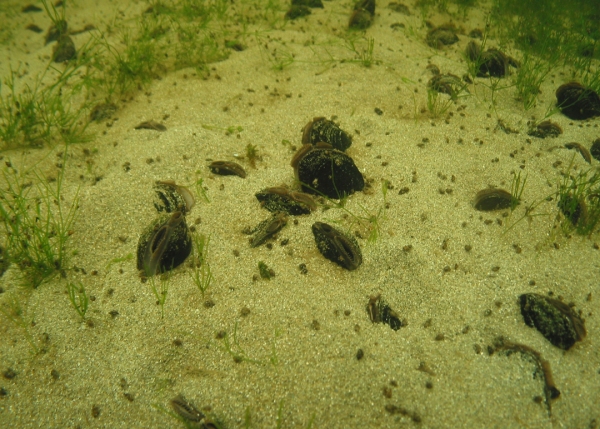
[Photo: Tracey Burton, NIWA]
Life cycle
Kākahi depend on native fish, because for part of their unusual lifecycle they become fish parasites by attaching themselves to the gills or fins of the host fish.
- Eggs The eggs are fertilised in the gill pouch of the female where they develop into larvae. The female releases them into the water when they are mature – possibly in response to the presence of a fish.
- Larvae Kākahi larvae called glochidia use hooks to latch on to a passing fishes gills or fins. There they can safely transform from larvae to mussel while they ‘hitch a ride’, hopefully upstream to good habitat.
- Juveniles Once juvenile kākahi detach from the host fish they are very difficult to find because they are very small and live below the sediment surface in streams or in other locations we haven’t yet discovered. Juveniles grow rapidly and are thought to be vulnerable to contaminants in the water possibly because they have a different feeding mode to adults.
- Adult kākahi Once juveniles have reached about 25mm length, they move into the same locations as adult mussels. At about four years of age (approximately 40mm long) they mature and are then able to reproduce with neighbouring kākahi. Males release their sperm into the water and nearby females collect it while filtering to fertilise their eggs.
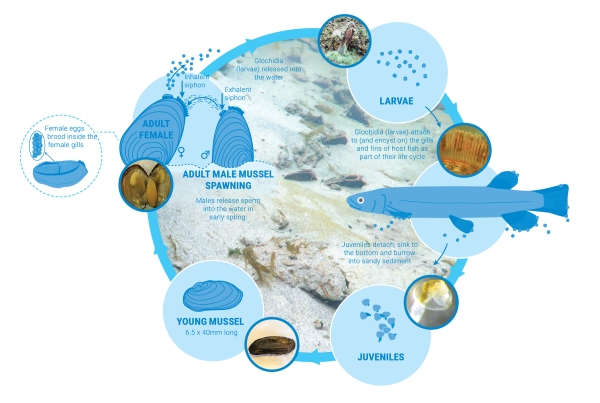
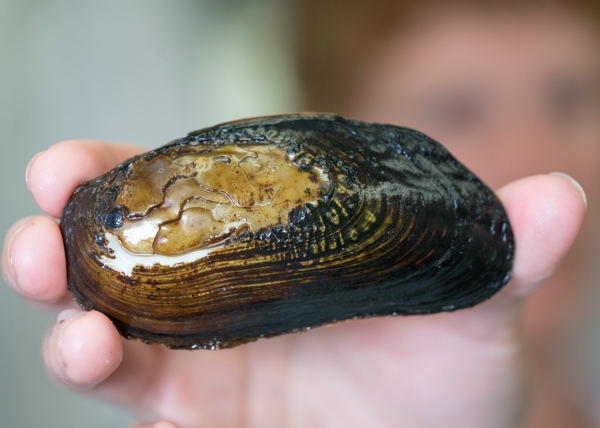
Stuart Mackay, NIWA Attribution, Non-Commercial, No Derivative Work
How old is this kākahi?
You can tell the age of kākahi by looking at the bands produced in their shell. This is done by cutting the shell from A to B (see photo below) so the bands inside the shell are exposed at right angles.
With the naked eye it is very difficult to see the bands, so they are counted using a microscope like the rings inside a tree trunk.Open configuration options
What do kākahi eat?
Kākahi are filter feeders and deposit feeders. They feed on algae, zooplankton and other micro-organisms which drift in the water. They also feed on sediment particles covered in bacteria.
Kākahi suck water in through their inhalant siphon and small particles are collected and sorted on the gill. The gill delivers the food to the mouth to be eaten, while wastewater flows out the exhalant siphon.
Adult kākahi are tolerant of some pollutants and will accumulate metals, organic contaminants and micro-organisms in their flesh and guts. This is why it is important to collect kākahi for eating from clean locations (unaffected by factors like wastewater or stormwater discharges and farming).Open configuration options
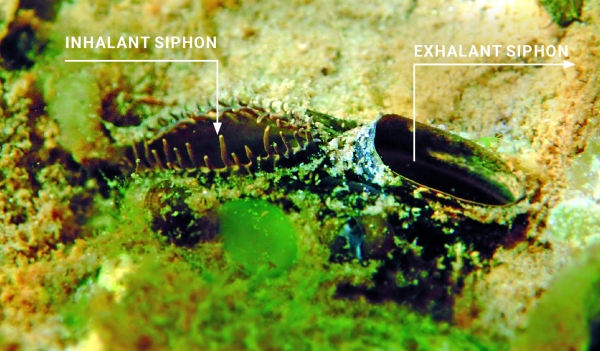
Kākahi conservation
Very little is known about the distribution of kākahi, which means that our knowledge of kākahi conservation is likely to be incomplete. Recent evaluations suggest that all three species of kākahi are under various degrees of threat. Also, there may be more species we haven’t discovered yet.
- Echyridella Menziesii - At Risk, Declining They occupy a large range (>100km2) but have low to high predicted decline at some locations (estimated at 10 to 70% over 10 years).
- Echyridella Onekaka - At Risk, Naturally Uncommon This is due to their range restriction, however, almost nothing is known about this species.
- Echyridella Aucklandica - Threatened, Nationally Vulnerable This is due to sparse distribution and failure to produce large numbers of juveniles.
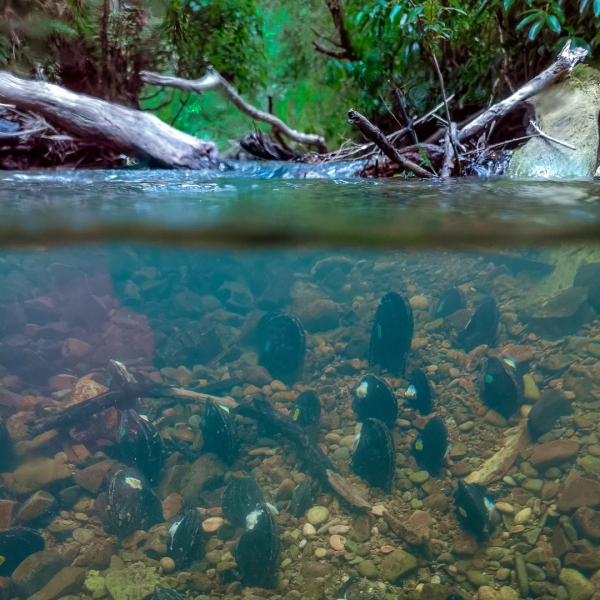
Michele Melchior
What are the threats?
There are several factors that may be causing a decline in kākahi populations.
Habitat loss and change
Changes to the natural environment can impact kākahi habitat. This includes the introduction of invasive fish, aquatic plants and rats.
Loss of vegetation-shading streams may increase water temperatures and changes to water flows may reduce kākahi habitat. Less water may dry out habitat, increase water temperatures, and allow smothering algal growth. Sudden increases in water flows can scour away the sandy places where kākahi live.
Pollutants such as excess nutrients, heavy metals, pesticides and sediments can kill kākahi. Juvenile kākahi are especially sensitive to contaminants.
Loss of host fish
The decline of native fish species which are a host for the larval/glochidia phase of the kākahi life cycle, can decrease juvenile production in kākahi populations.
What can you do to help?
The current conservation status is “At Risk” or “Threatened”.
With more information we will be able to better track kākahi populations, and come up with new ways to protect them. If you come across kākahi, please keep records of your observations to the best of your ability by recording:
- Location (GPS)
- Estimate of abundance
- Size and condition
- Species
- Habitat
All observations can be submitted to the Freshwater Fisheries Database.
Download
- Kākahi: What does science tell us about New Zealand freshwater mussels (PDF 4.9 MB)
- Kākahi lifecycle poster - Te Reo (PDF 1.64 MB)
- Kākahi lifecycle poster - English (PDF 1.6 MB)


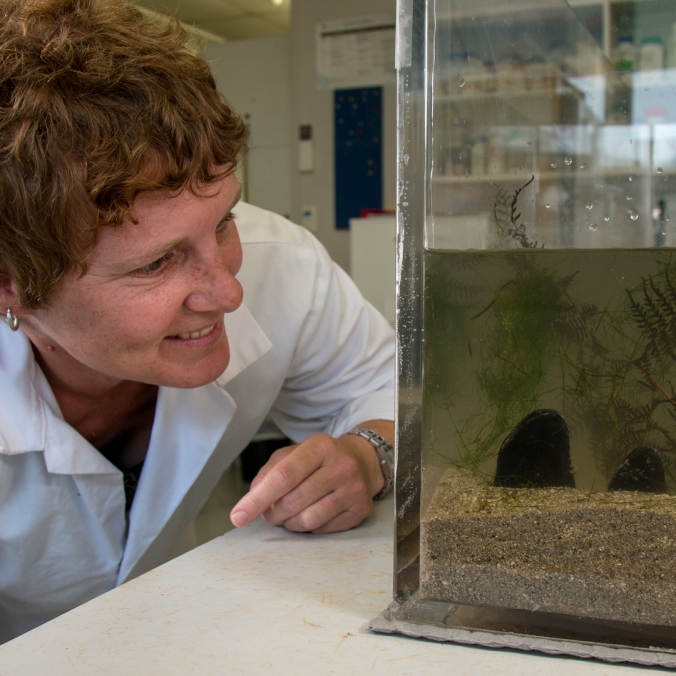
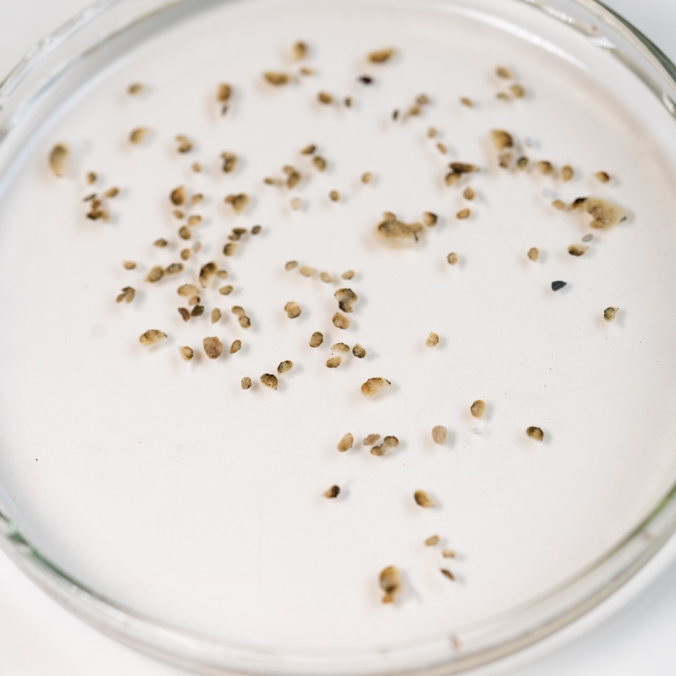
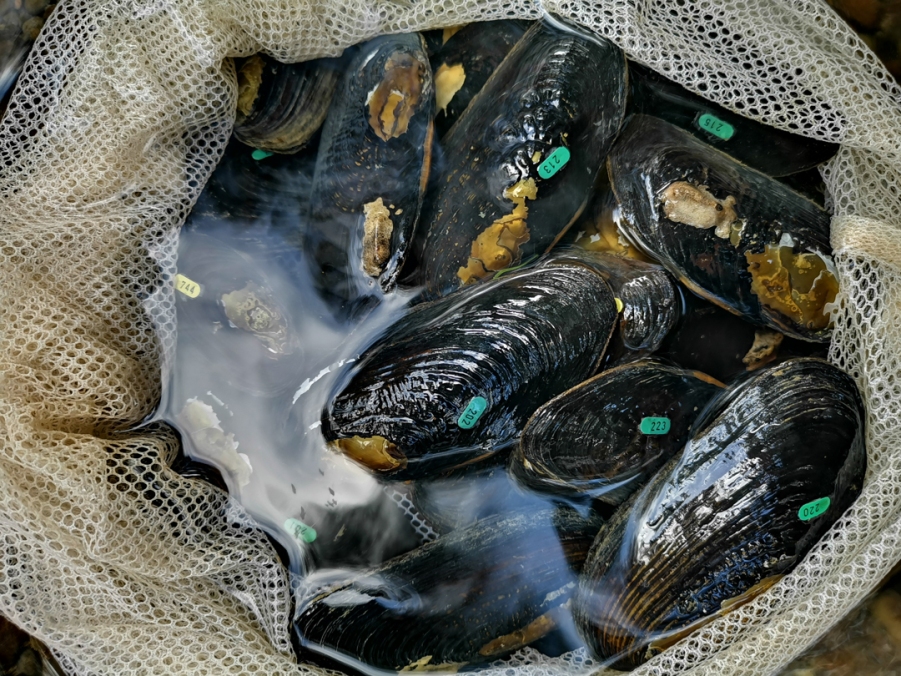
![Often all you will see of a kākahi is their siphons poking out of the sediment [Photo: Tracey Burton, NIWA]](/sites/default/files/styles/gallery/public/WEB-Kakahi-in-lake-Brunner2.jpg?itok=mYdHiNFm)

